DescriptionProduct CodesContact
Extent the life of your tire with LiquiTube, a premium, heavy duty tire sealant.
Download the LiquiTube Tire Guide in PDF Format: LiquiTube Tire Guide. Cliquez ici pour le français
| Type | Volume | Code |
|---|---|---|
| Bottle | 237 ml / 8 oz | #95522 |
| Bottle | 473 ml / 16 oz | #95533 |
| Bottle | 946 ml / 32 oz | #95544 |
| Jug w/ pump | 3. |
#95555 |
| Pail | 18.9 L / 5 gal | #95566 |
| Pail & Pump Combo | 18.9 L / 5 gal | #95577 |
| Drum | 208 L / 45 gal | #95578 |
| Tote | 1040 L / 225 gal | #95579 |
| Type | Volume | Code |
|---|---|---|
| Pump for #95566 Pail | #95588 | |
| Pump for #95578 Drum | #95589 | |
| Pneumatic Pump for #95579 Tote | #95599 | |
| Description | Code |
|---|---|
| Dual Reverse Chuck Installation Tool | #95590 |
Easy to install, with installation tool included, LiquiTube stops flat tires before flat tires stop you.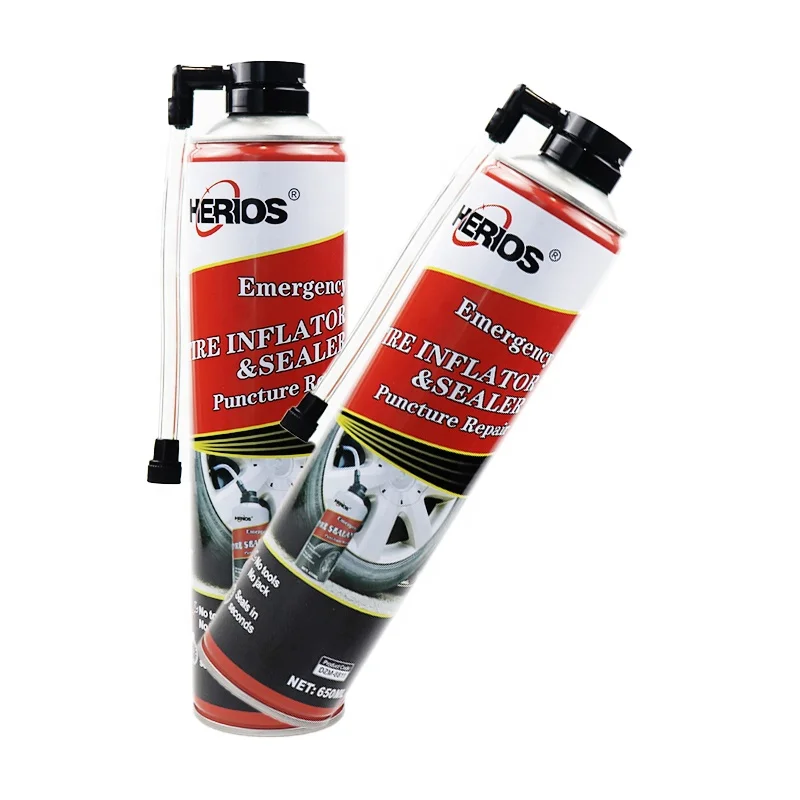
Ideal for:
So. ..is LiQuiTube any better than a regular inner tube?
..is LiQuiTube any better than a regular inner tube?
You should try LiQuiTube TODAY!
Why The Way They Are Made Makes All The Difference
When judging tire sealants, it is important to understand that only Liquitube is made with a multi-stage, heat mixing process. This special process makes Liquitube unique in how it works, how long it lasts, and other factors.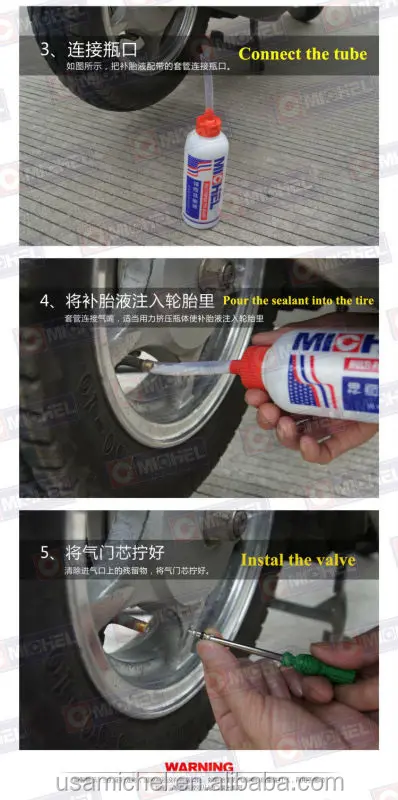 All other tire sealants are "cold-mixed" products, which limits their abilities and their effective life.
All other tire sealants are "cold-mixed" products, which limits their abilities and their effective life.
Shelf Life
Unlike cold-mix sealants, Liquitube has NO known shelf-life and stays liquid for the life of the tire, guaranteed.
Fully Coated
Unlike cold-mix sealants, Liquitube actively coats every square inch of the inside of the tire and rim, sealing ALL forms of air loss.
Temperature Range
Unlike cold-mix sealants. Liquitube remains effective from as low as 50 below zero and as high as 200 degrees.
Punctures
Unlike cold-mix sealants, Liquitube seals 1/4" punctures in ANY tire, and 3/4" punctures in heavy ply tires.
What Mess?
Unlike cold-mix sealants, Liquitube will not dry out in the tire, or make a mess when the tire is removed from the rim.
Safe & Washable
Unlike cold-mix sealants, Liquitube washes off completely with water, and meets EPA guidelines for municipal disposal.
Lifetime Guarantee
Unlike cold-mix sealants, Liquitube has a LIFETIME GUARANTEE!

Kindly allow me to tell you about a tire sealant our company, Watsontown Trucking, has tested and were very impressed with.
We put around 8 different types of screws into a tire and then added LiQuiTube Tire Sealant to see what would happen. In our test it took several revolutions then the LiQuiTube sealed all the punctures caused by the screws in the tire.
So, next we ordered (2) 55-gallon drums of LiQuiTube and several months later we ordered a 275-gallon tote. Watsontown Trucking has 300 tractors and 1,300 trailers and we cannot afford downtime or road calls. We have customers across the east coast that we service, and we need to meet their deadlines daily.
Plus, the safety LiQuiTube adds for our drivers is huge. Thank You.
Larry Bieber
Continuous Improvement Manager
Watsontown Trucking Company
Family Owned Since 1941
Milton, PA 17847
One of the best things you can do to get the most miles out of your tires is to stay on top of balancing.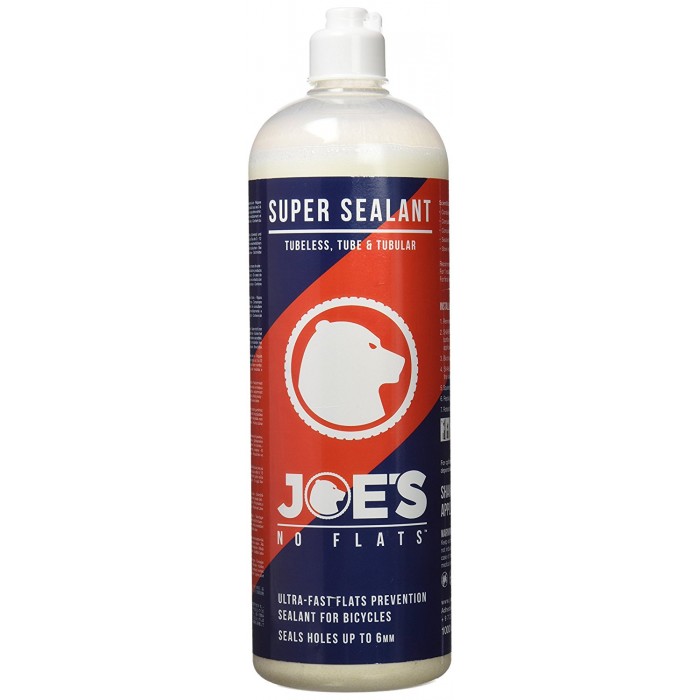 How frequently should tires be balanced? Should I use wheel weights or internal balancing compounds? Are there best practices a fleet should consider to minimize the impact of tire imbalance?
How frequently should tires be balanced? Should I use wheel weights or internal balancing compounds? Are there best practices a fleet should consider to minimize the impact of tire imbalance?
https://www.ccjdigital.com/maintenance/article/15289585/truck-tire-maintenance-includes-balancing
LiQuiTube provides peace of mind and more fun in all your outdoor activities!
For all your ATV, Mowing, and Equipment needs, find your local LiQuiTube dealer.
Liquitube Tire Sealant has worked amazingly well for our farm UTVs (which are actually retrofitted GeoTrackers). We run them hard, but the tire sealant does the job and we have no trouble with flats or even slow leaks. It’s the way to go!
Rodrick Shank
The Family Cow
Chambersburg, PA
www.yourfamilyfarmer.com
Since we became a dealer for LiQuiTube Tire Sealant over 3 years ago, we have installed LiQuiTube in about 60% of our new Equipter sales.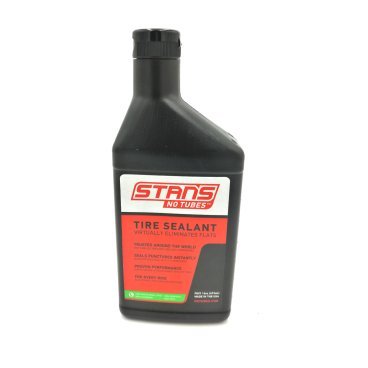 We also use LiQuiTube on quite a number of Equipter's that we service for our customers and have seen incredible results. We have had so much successful feedback from our customers that I can say: "this is an outstanding product". As one of our repeat customer says: "It has cut our down time due to flat tires to almost nothing." I would highly recommend this product to anyone that has an application when flat tires is a constant issue.
We also use LiQuiTube on quite a number of Equipter's that we service for our customers and have seen incredible results. We have had so much successful feedback from our customers that I can say: "this is an outstanding product". As one of our repeat customer says: "It has cut our down time due to flat tires to almost nothing." I would highly recommend this product to anyone that has an application when flat tires is a constant issue.
Billy Waldner
Service & Support
855-378-4783
www.equipter.com
"We have been using LiquiTube in our fleet for over a year now, and have noticed reduced puncture repairs. Our aluminum rims are not pitted and corroded as with other sealants. We will continue to use this product, and hope to see even more results."
Christian Andersen
Transportation Manager
Snavely's Mill Inc - Lititz, PA
www.snavelysmill.com
Power Pro Equipment has added a new product line in all of our 6 locations..jpg) We are pleased to be a dealer of LiQuiTube Tire Sealant, the #1 Best Selling Heavy Duty Commercial Tire Sealant in the USA. Power Pro Equipment does a large volume of Pettibone service, repair and rental consistently throughout the year. Prior to being introduced to LiQuiTube Tire Sealant we were spending between $3000 & $4000 per unit in tire repairs. Since implementing LiQuiTube Tire Sealant we have seen a savings of $30,000 a year. Power Pro has seen the benefit of using this product day in and day out from a cost savings perspective, to performance, and operator ride. Our customers have come to appreciate our knowledge of products we use. Many of our customers are investing in LiQuiTube Tire Sealant, and they too are seeing the benefits. Power Pro has seen what this product can do, and the cost saving impact it can have. If you have not tried LiQuiTube Tire Sealant I encourage you to do so.
We are pleased to be a dealer of LiQuiTube Tire Sealant, the #1 Best Selling Heavy Duty Commercial Tire Sealant in the USA. Power Pro Equipment does a large volume of Pettibone service, repair and rental consistently throughout the year. Prior to being introduced to LiQuiTube Tire Sealant we were spending between $3000 & $4000 per unit in tire repairs. Since implementing LiQuiTube Tire Sealant we have seen a savings of $30,000 a year. Power Pro has seen the benefit of using this product day in and day out from a cost savings perspective, to performance, and operator ride. Our customers have come to appreciate our knowledge of products we use. Many of our customers are investing in LiQuiTube Tire Sealant, and they too are seeing the benefits. Power Pro has seen what this product can do, and the cost saving impact it can have. If you have not tried LiQuiTube Tire Sealant I encourage you to do so.
Dwight Hurst
Owner
Power Pro Equipment
www.powerproequipment.com
What's the #1 reason for OTR breakdowns?
What's the #1 reason for hours lost on OTR breakdowns?
What's the #1 reason for OTR trailer breakdowns?
TIRES
Underinflation causes:
seperations, circumferential breaks, higher risk of road hazard, loss of fuel economy, uneven/irregular wear, higher risk of road hazard, higher downtime expense, loss of casing durability
The TMC road debris study confirmed again that underinflation due to road hazards or poor maintenance resulted in almost 90% of tire failures.
Proper tire inflation of radial truck tires is the most important maintenance practice to ensure long tire life. Once proper tire inflation has been determined, it should be maintained at that level as consistently as possible. Underinflation must never be allowed in over-the-road truck tires.
The American Trucking Association says a difference of 10 pounds in air pressure between over-the-road tires can drag the lower pressured tires 13 feet per mile. Tires running 10% under-inflated lose up to 16% of their treat life. Poor inflation rubs away the life of the tire.
According to a 2006 congressionally mandated TRB study on fuel efficiency, The US Department of Transportation says passenger cars and light trucks use an estimated 130 billion gallons of fuel per year. In addition, the designated economist on this issue estimates that vehicles with underinflated tires waste approximately 1.2 billion gallons of fuel per year due to the increased resistance of the tires.
Dutch Transport has been using LiQuiTube Tire Sealant for several years.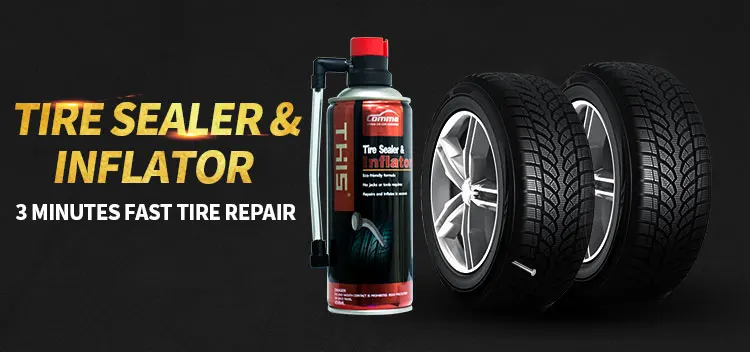 And it certainly saved us many times from getting nails and screws and punctures we were getting before. The investment is definitely worth the relief from stress and downtime and road calls we had to pay. I would recommend LiQuiTube for any over the road trucking company. The benefits and the down time you save plus longer tire life gives your drivers peace of mind daily.
And it certainly saved us many times from getting nails and screws and punctures we were getting before. The investment is definitely worth the relief from stress and downtime and road calls we had to pay. I would recommend LiQuiTube for any over the road trucking company. The benefits and the down time you save plus longer tire life gives your drivers peace of mind daily.
John Mentzer, Head Mechanic
Dutch Transport, LLC
154 Orlan Road
New Holland, PA 17557
https://www.facebook.com/DutchTransportLLC/
Pit & Quarry says, "A sound inflation program is the single most important factor with regard to tire performance. A tire inflated to 70% of ites recommended air pressure will wear out or, most likely, fail during the first 50% of its life."
Equipment World says, "Keeping tires at 100% inflation allows them to run at 100% effectiveness. Tire-related costs are the single largest maintenance expense for most contractors and while tire costs are not escapeable they are containable.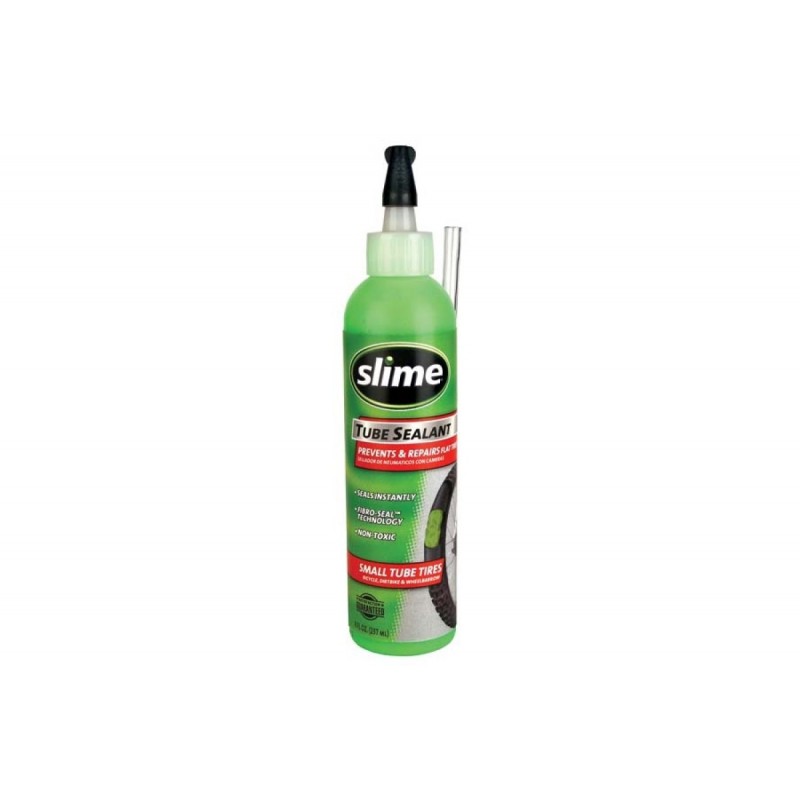 "
"
Some things to consider are: Tim Good, Goodyear's manager of global accounts, says improper tire inflation increases a contractor's annual new and retread tire costs by about 10%-13%. According to Michelin, if a tire is under-inflated by 20%, the life of the tire decreases by the same percentage. Keeping tires at the target pressure increases the number of hours they last and the equipment runs.
Construction Equipment says the most important part of a tire is the air, but keeping the proper inflation in every tire is still probably the toughest challenge in maintaining a fleet of wheeled vehicles. Very few do it well, and its expensive. If your tire pressures are 20% off (for example, running 28psi in a tire that should have 35psi), your annual tire costs will be 25% higher than normal. Keep tires at the right pressures and your rubber-tired machines will work cheaper than your competitors.
Farm Industry News says Firestone, Goodyear, and Titan will all tell you the same thing. "What air is to a tire, oil is to an engine, and water is to a radiator" says Len Wagner, global field engineering manager with Firestone Ag. "If you don't have it in the proper amount, failure can occur." Proper inflation can more than double the life of an ag tire. Underinflation causes the sidewall to deflect more than it was designed to do and will cause permanent failure.
"What air is to a tire, oil is to an engine, and water is to a radiator" says Len Wagner, global field engineering manager with Firestone Ag. "If you don't have it in the proper amount, failure can occur." Proper inflation can more than double the life of an ag tire. Underinflation causes the sidewall to deflect more than it was designed to do and will cause permanent failure.
Carlisle tires says the worst enemy a tire can have is too little inflation pressure. It can reduce fuel economy through increased rolling resistance. When a tire is under inflated, it reduces tread life through increased wear on the outside edges of the tire. It also generates excessive heat, which reduces tire durability. Uneven wear reduces the useful life of a tire. Soft tires make your equipment work harder.
A car tire puncture is an unpredictable phenomenon. A spare or stowaway will of course help, but in some cases a faster method of troubleshooting may be required.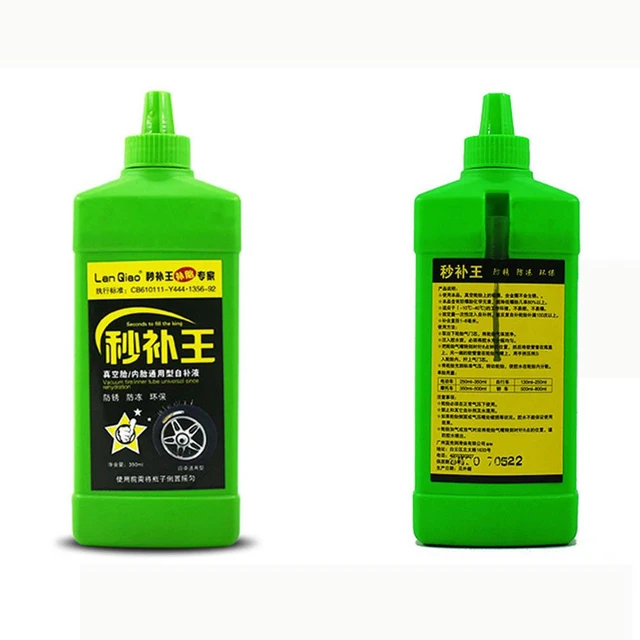 For girls, changing a wheel can be a serious test. In such situations, a special material - tire sealant - can become a reliable means of repairing a puncture.
For girls, changing a wheel can be a serious test. In such situations, a special material - tire sealant - can become a reliable means of repairing a puncture.
In most cases, tire sealant is an aerosol can containing a special chemical material that seals the tire from the inside. nine0003
The composition of the sealants are:
The latex sealant works from the inside of the tire. The material covers the inner surface, and getting to the place of breakdown, isolates it. Compositions based on synthetic or natural fibers are made on the basis of asbestos, polyethylene or paper. They, unlike latex sealants, act only at the puncture site itself. nine0003
By appointment means for tires are preventive and repair.
Means for preventive purposes are used in order to prevent a possible breakdown of rubber. A special sealing compound is fed through the nipple into the tire.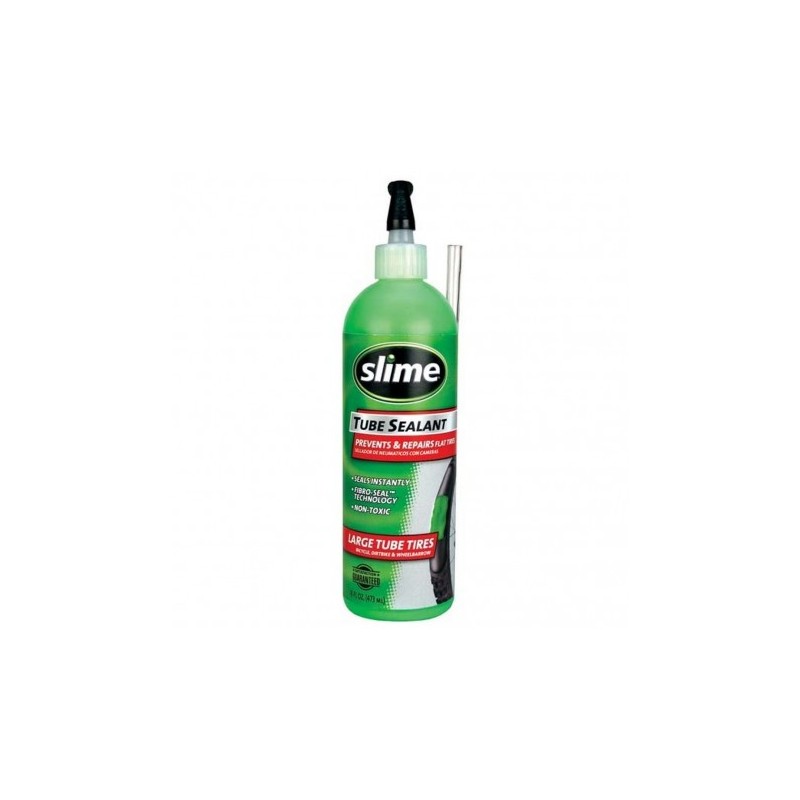
Under the influence of centrifugal force, which occurs when the vehicle is moving, the material is distributed over the inner surface of the tire. nine0003
When a tire breaks down, into which a preventive sealant is poured, there is no pressure drop in the wheel.
If the tire is with a chamber, then the composition is poured between the balloon and the tread layer. Due to the air cushion that is present in the wheels with the camera, heating can occur. Since the material withstands high temperatures, it contributes to the cooling of the tread. When using a preventive sealant in tubeless tires, the composition is distributed inside the wheel and prevents the occurrence of punctures and cracks. nine0003
Additional functions of sealants:
Repair sealants are used if a puncture has already formed and it is urgent to restore the integrity of the wheel in order to continue further movement.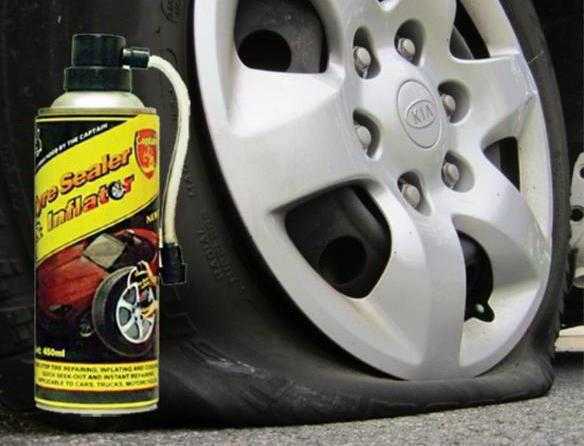 nine0003
nine0003
When the material is injected, the pressure in the tire increases and the tire takes shape. A film or liquid is formed inside the wheel, which, under the influence of centrifugal force, is evenly distributed inside the wheel and clogs the sample.
In addition to aerosols, there are materials in vials. They do not increase tire pressure, so the tire must be inflated after they are inflated. But such materials can be used with fully flat tires. nine0003
Repair sealants can only be used in tubeless tires. In tires with chambers, their use is unacceptable, since such material will simply glue the cylinder to the inner surface, and the wheel will become unusable.
There are a lot of tools for repairing punctured wheels on the market. In order to attract a potential buyer, manufacturers prescribe "tasty" properties to their products. But, if we put aside all the marketing tricks, to select the optimal tool, you should pay attention to the following characteristics.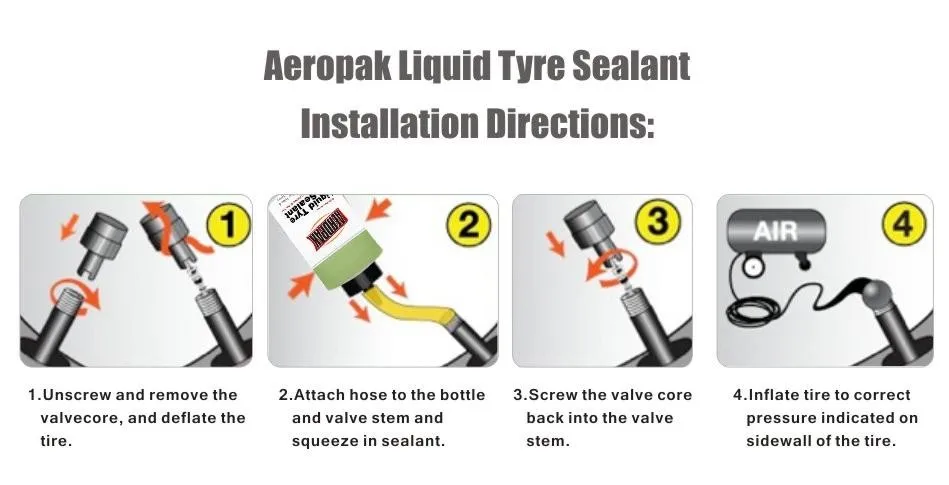 nine0003
nine0003
Firstly, this is the purpose of the material. Aerosol wheel sealants, unlike those sold in bottles, have the additional function of increasing the pressure inside the tire. In terms of efficiency, it is impossible to say exactly which composition is better, but the ability to increase tire pressure can be indispensable, especially in cold or rainy weather.
The second is the operating temperature range of the sealant, namely frost resistance. At negative temperatures, some compounds crystallize, lose their properties and become completely useless. nine0003
An important role is played by the volume of the sealant. For example, 300 ml of spray is enough to eliminate a puncture in a small car tire, but this is not enough to repair an SUV wheel. Therefore, the dimensions of the installed tires should be taken into account.
This information is contained on the label or instructions for use.
Do not forget about the types of tires installed on the car.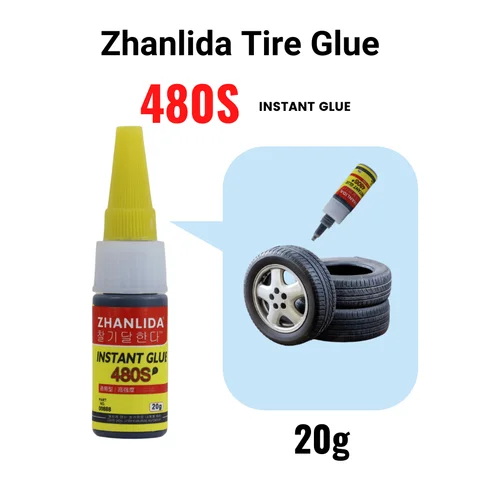 Different sealants are used for tubeless and tube tires, but there are also universal compounds that are suitable for both types. nine0003
Different sealants are used for tubeless and tube tires, but there are also universal compounds that are suitable for both types. nine0003
You also need to consider the number and size of punctures. Sealants can repair up to 6 punctures at the same time. At the same time, no composition will close up holes larger than 1 cm.
In addition to the above nuances, there are some difficulties that may arise when using a sealant.
Remember that the effect of tire adhesives is short-lived. Depending on the material, a retreaded wheel can be driven from 10 to 20 kilometers at a speed not exceeding 40-50 km/h. nine0003
To eliminate lateral damage with the help of such sealants will not work. It's all about centrifugal force, due to which the composition remains only in the projector area, and does not flow onto the side surfaces. Also, do not use sealants if the wheel is deformed.
If you are using aerosols that contain flammable gases, then the wheels should not be inflated with air. During driving, the rubber heats up and the mixture inside can ignite and explode. nine0003
Repairing a wheel with sealants is not a difficult procedure. The main thing is to follow certain rules that depend on the material used.
First you need to remove the object that caused the puncture or, if it is not there, find a hole. Then you need to turn the wheel so that the damage is on top. With a completely flat tire, bleed off any remaining air.
The application of most sealants requires the removal of the spool, but with aerosols such manipulations are not necessary. Check the instructions for the material to see if the spool needs to be removed. nine0003
Next, you need to install the tip of the cylinder or tube into the valve and press on the valve. Repair can be considered completed as soon as the wheel becomes the desired shape. After that, you should measure the pressure in the tire, and, if necessary, bleed or inflate the wheel.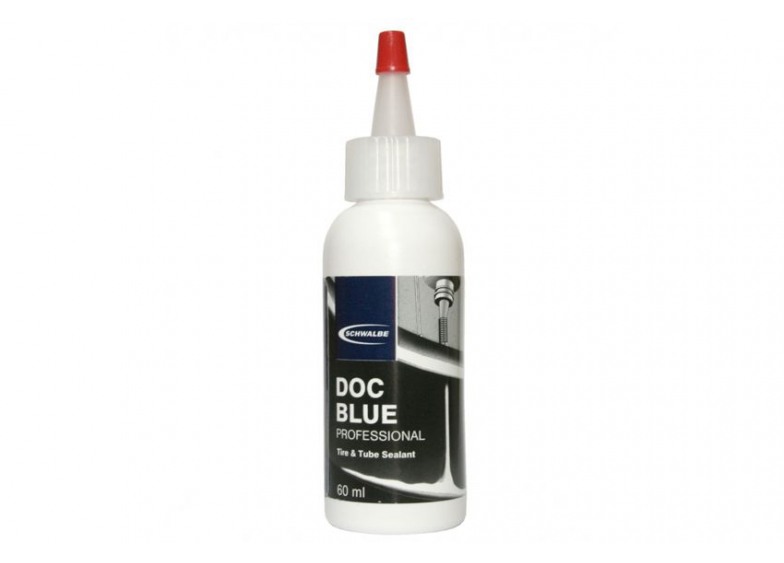
After a short trip (2-3 km) you need to check the tire pressure. This is due to the fact that some compounds are active for a long time. Therefore, in order not to drive on overinflated tires, it is important to know exactly what air density is in the wheels. nine0003
The procedure for working with a fluid sealant is almost the same as with an aerosol one. The main difference is that the wheel after filling the product must be turned several times and then pumped up to the desired pressure.
KEVLON Anti-Puncture is a tire life extension product. Tire sealant is a chemical solution that is injected into a tire to provide permanent protection against air leakage throughout the life of the tire and to increase tire life. nine0003
Learn more at What is Kevlon Sealant?
KEVLON sealant has a shelf life of 5 years. But in practice, there were cases when KEVLON brand products were kept by thrifty drivers for 8 years and then were used for their intended purpose.
Yes, it is mandatory. Remove the object from the tire, check the air pressure in the wheel, after overcoming a certain distance, check the pressure in the wheel again. nine0003
yes, KEVLON sealant is guaranteed for one year. KEVLON sealant does not affect the tire manufacturer's warranty. In fact, KEVLON sealant even exceeds the tire manufacturer's warranty requirements.
KEVLON sealant warranty means that:
Your tires will never deflate due to a puncture less than 6.35 mm in diameter for the High Speed series and a puncture with a diameter less than 20 mm for the Off Road series in the tread area for the entire duration of normal tire life. nine0003
Your tires will never deflate due to porosity and rubber delamination;
KEVLON Sealant will keep the air in the tires and provide permanent protection.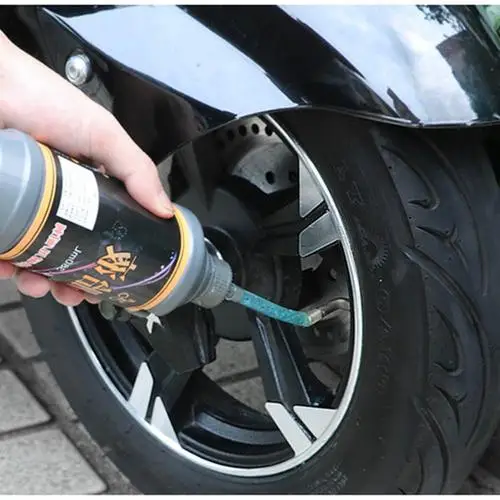
Our clients are varied. KEVLON tire sealant is used by construction companies, police, municipal organizations, truck fleets, mining companies, industrial organizations, utilities, new car dealers, used car dealers, private owners. nine0003
liquid tire sealants are generally paste, solvent, latex based and freeze at temperatures below -10°C. Many liquid tire sealants cure and cause imbalance and damage to the rubber compound. And this, in turn, reduces the life of the tire. KEVLON anti-puncture sealant is based on ethylene glycol and will not deteriorate or dry out inside the tire. KEVLON Sealant, when properly filled, will keep the wheel balanced. nine0003
See the Glycol vs Latex page for tire sealant differences
aerosol products are latex based and should only be used after a tire has been punctured. And even then they seal the puncture temporarily. After applying such a sealant, the tire will still need to be taken to a workshop for repair, where it will be dismantled, the sealant removed, the puncture sealed and installed back. And all this at the expense of the user. nine0003
And even then they seal the puncture temporarily. After applying such a sealant, the tire will still need to be taken to a workshop for repair, where it will be dismantled, the sealant removed, the puncture sealed and installed back. And all this at the expense of the user. nine0003
KEVLON Tire Sealant is an ethylene glycol-based preventative designed to increase tire life. It is non-flammable and non-explosive. KEVLON sealant does not harden inside the tire and maintains balance. The KEVLON anti-puncture device is capable of operating in a wide temperature range down to -50°C. up to +150°С
KEVLON High Speed Sealant is sold in 20 liter cans.
KEVLON Off Road Sealant as an emergency sealant for passenger cars in 1.25l bottles. And also for special equipment in canisters of 5, 25 and 200 liters.
yes. KEVLON brand products are a registered European trademark.
Air escaping from the tire draws the sealant into the hole. The fibers and liquid accumulating in the hole seal the puncture. nine0003
yes. KEVLON Sealant covers the hole area after removing the item from the tire. The wheel must remain on the vehicle so that when rotated, the hole expands and passes the KEVLON sealant into itself. If you do not start driving immediately after removing the object from the tire, the tire may flatten.
no, KEVLON sealant is a homogeneous mixture with ingredients combined in such a way that they cannot settle on the bottom. This fact is a big advantage over other water based or latex based sealants.
No. KEVLON tire sealant is chemically inert.
KEVLON Tire Sealant has been tested at -60°C (the lowest test temperature under these laboratory conditions) and has not frozen. It should also be noted that the sealant remains in a stable state when the tire is very hot, leading to tire damage.
Yes, because KEVLON Sealant does not chemically bond to the tire, it can be easily washed off with a hose. This is an important point as the tire can be washed, retreaded and welded on after using KEVLON sealant. In addition, if a tire puncture is too large, which cannot be repaired with KEVLON sealant, it can be washed, repaired and refilled with KEVLON. nine0003
Does not call.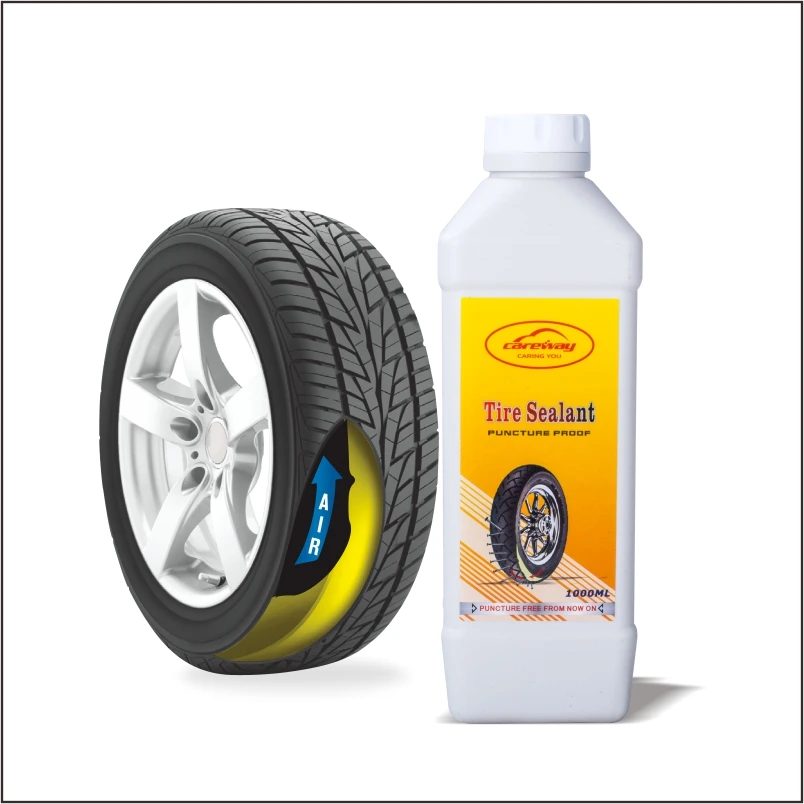 KEVLON Sealant contains anti-corrosion additives to prevent corrosion and eliminate existing corrosion.
KEVLON Sealant contains anti-corrosion additives to prevent corrosion and eliminate existing corrosion.
HIGH SPEED Series Sealant - no, Off Road Series - yes. They have different specifications and different areas of application. KEVLON High Speed Sealant contains specially selected adhesive additives to prevent runoff. The sealant stays in place and coats the inside of the tire all the time, whether the wheel is spinning or not. To fully distribute KEVLON High Speed Sealant to the inner surface of the tire, it is necessary to drive about 20 km at the highest possible speed. nine0003
no. KEVLON Sealant can seal a puncture, but the sidewalls of the tire are subject to severe bending and deformation. In case of lateral damage, the tire must be disposed of.
no. The cork will be elastic. It was deliberately designed this way as tires are prone to flexing and a solid cork (repair with harnesses) will not be able to flex with the tyre, which in turn will cause air to leak. nine0003
The cork will be elastic. It was deliberately designed this way as tires are prone to flexing and a solid cork (repair with harnesses) will not be able to flex with the tyre, which in turn will cause air to leak. nine0003
no. KEVLON Tire Sealant always stays in the same condition it was in when it was put into the tire, as the tire is a closed vessel with no liquid and no chance of evaporation.
this is possible, but rare, if polymer particles get into the nipple and create a plug in it. In such a situation, blow out the nipple to remove the plug. If air does not enter the tire, clean the nipple with improvised means or flush it with water. nine0003
no, tire pressure must not exceed 3.0 bar.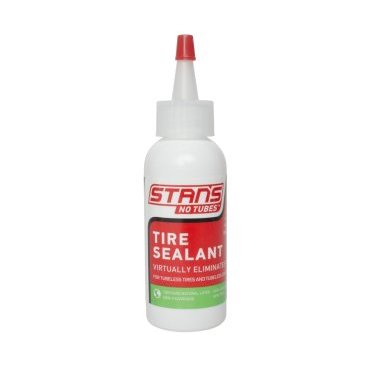 After the introduction of KEVLON anti-puncture, the tire must be inflated to operating pressure. Or use a PERSOL pneumatic pump to charge the sealant.
After the introduction of KEVLON anti-puncture, the tire must be inflated to operating pressure. Or use a PERSOL pneumatic pump to charge the sealant.
yes, this requires high-tech equipment, which is used in mining enterprises operating super-heavy dump trucks. In this situation, it is not necessary to deflate the tires before applying KEVLON Tire Sealant. nine0003
the following tools are required:
no. KEVLON tire sealant is non-flammable. It is based on glycol, in other words, antifreeze. Antifreeze does not burn.
no.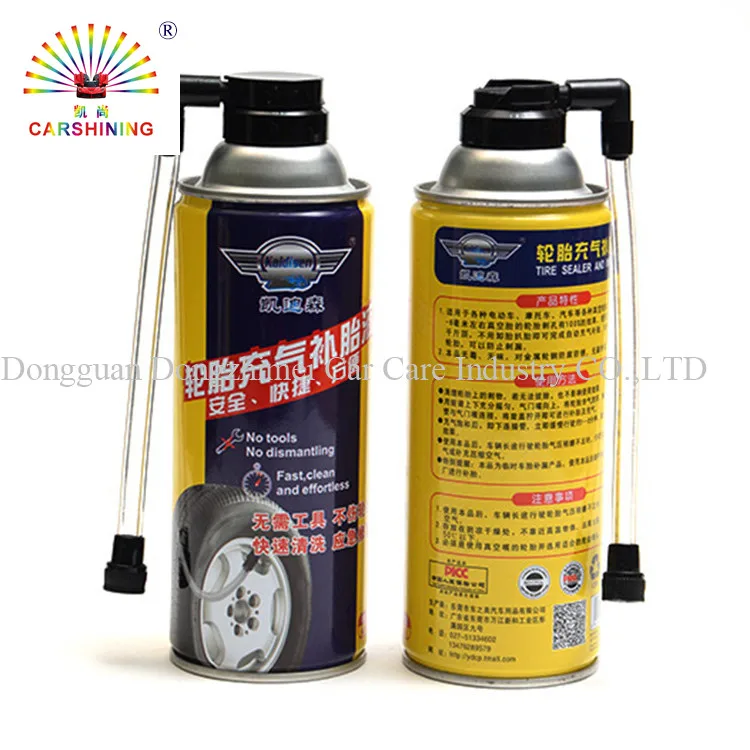 KEVLON Sealant is environmentally friendly, non-flammable, non-toxic and non-explosive. Not to drink. Keep away from children.
KEVLON Sealant is environmentally friendly, non-flammable, non-toxic and non-explosive. Not to drink. Keep away from children.
yes. After application, KEVLON anti-puncture remains in a liquid state for the entire period of operation of the tire and wheel. As the wheel rotates, the centrifugal force distributes the solution evenly over the inside of the tire. With any puncture, thousands of closure fibers will seal the hole and prevent air from escaping. Such actions will be repeated with each puncture. nine0003
KEVLON Tire Life Extender is injected quickly and easily through the nipple using a dosing pump (average injection time into the tire is only a few minutes).
yes, but for older tires, apply 10-15% more KEVLON sealant than indicated in the table.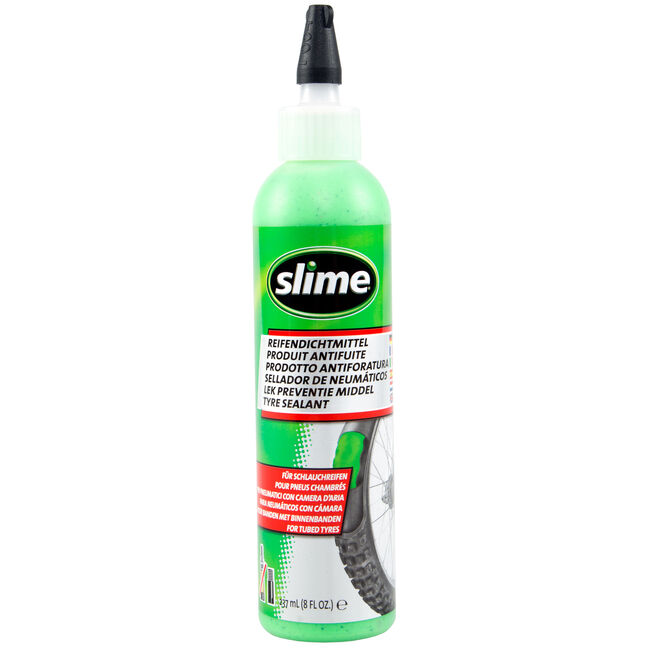 Due to the presence of open pores in the old tire, a certain amount of KEVLON anti-puncture will be absorbed. nine0003
Due to the presence of open pores in the old tire, a certain amount of KEVLON anti-puncture will be absorbed. nine0003
KEVLON Sealant should only be used on pneumatic tires. KEVLON Sealant can be used in tube and tubeless tyres.
Check with Kevlon staff at [email protected]
Or use the online chat in the lower right corner of the site. nine0003
This depends on the brand of the pump, please contact the supplier of the product for details. Proper operation of the pump is in the VIDEO section of this website.
this is impossible to predict as the answer depends on many factors such as hole size, air pressure, surface area, as well as puncture time (whether in motion or not), tire size and amount of sealant poured
With multiple punctures, it is likely that a large amount of sealant will come out and the air pressure will decrease to a level at which it will no longer be possible to ensure a good sealing of the punctures.